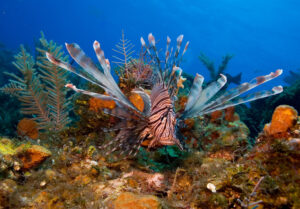Goodbody-Gringley, G., Chequer, A., Grincavitch, C., Noyes, T., Dowell, R., Lundberg, A., Corbett, E., & Smith, A. (2023). Impacts of recurrent culling of invasive lionfish on mesophotic reefs in Bermuda. Coral Reefs, 42, 443–452. https://doi.org/10.1007/s00338-023-02354-y
Lionfish invasion
Lionfish (Pterois miles and Pterois volitans) are one of the most prevalent and destructive invasive species in the Western Atlantic Ocean. An invasive species is a non-native animal that quickly adapts to its new territory. Lionfish, native to Indo-Pacific coral reefs, were introduced to the Western Atlantic through aquarium releases in the mid-1980s. They’ve since spread all the way from northeastern United States to southern Brazil. Because lionfish in these areas are unrecognizable to native marine animals, they don’t have any natural predators to control their populations. Furthermore, lionfish don’t have a picky diet and eat a ton of food – up to 4% of their bodyweight each day! – which can take a huge toll on native reef fish populations. Reefs with an abundance of lionfish have a significantly smaller fish community, which can seriously harm reef biodiversity and resilience.
In Bermuda, lionfish densities are much higher at deeper reefs compared to shallow reefs. These deeper reefs, or mesophotic reefs, are essentially low light reefs that can extend from 130 feet (30 meters) to 490 feet (150 meters). Researchers think that lionfish take refuge and reproduce in mesophotic reefs. Therefore, finding ways to control their populations at these deeper sites is critical for maintaining a healthy reef system.
Removal efforts in Bermuda

Lionfish culling, which is the removal of select individuals from an area, began in 2012 in Bermuda with the establishment of the Bermuda Lionfish Task Force. Culling strategies include spearing lionfish and placing lionfish-specific traps.. While these methods successfully reduce lionfish numbers in shallow reefs, removing lionfish in mesophotic reefs is more complicated. Mesophotic reefs are found at deep depths, beyond the limit of traditional SCUBA and requiring advanced technical diving skills and equipment. To determine if it’s worth the effort, researchers set out to measure the efficacy of short-term culling of mesophotic lionfish populations on lowering lionfish densities and mitigating impacts to native reef fishes.
Counting and culling fish
Starting in July 2017, lionfish and native fish density surveys were conducted monthly through December 2017 at three study sites in Bermuda. At each site, divers swam in a zigzag formation within a 25 meter by 10 meter quadrat, closely examining the habitat for lionfish. All lionfish encountered within the area were counted and culled by spearing. Then they were brought back to the laboratory to check the sex. The number of native fish at each site was determined using the belt transect method. For this method, divers swam along a 30 meter-long transect and counted any fish within 1 meter of the transect line. The species and estimated length of each fish were recorded. After the monthly surveys were completed, two subsequent lionfish and native fish surveys were conducted in May 2018 and January 2019 to test the efficacy of the culling.

Will this be enough?
Lionfish densities significantly declined after six months of culling but rebounded slightly during the six-month break. After the repeat culling in May 2018, though, the population remained much lower through the following culling in January 2019. There was also a lower percentage of females over time, indicating that culling may affect the reproductive potential of the population. Surprisingly, the number of native reef fish actually declined with the lionfish population. This is the opposite of what the researchers expected. They hypothesized that this may be due to natural changes in oceanographic conditions that dictate seasonal fluctuations in fish community. So, environmental conditions may have a stronger impact on native reef fish populations than lionfish presence. Researchers think this same reasoning could be applied to the decline in lionfish populations, too. Changes in environmental conditions may affect lionfish populations more than the short-term culling. Therefore, continuing with short-term culling and monitoring of lionfishes in particularly high density areas is the most effective means towards population control.
Overall, this study provides an encouraging outlook on the frequent and short-term culling of lionfishes in mesophotic reefs. Targeting invasive lionfish populations in high density sites can successfully remove a significant number of lionfish, while subsequent and infrequent culling can maintain these lower numbers. This is a critical step for lionfish management efforts in Bermuda, where reef resilience and biodiversity largely depend on the control of this invasive species.
Cover photo by LASZLO ILYES, CC BY-NC 2.0.

I’m an MSc student in marine biology at the University of Hawaiʻi at Mānoa. I conduct research through the Johansen Fish Resilience Lab at the Hawaiʻi Institute of Marine Biology. I’m currently studying the effects of sedimentation on the foraging behavior of herbivorous coral reef fish. Before grad school, I got a double BS in environmental geology and environmental studies at Tufts University before working at a shark research lab in the Bahamas. In my free time, you can find me climbing, running, or reading at the beach.

